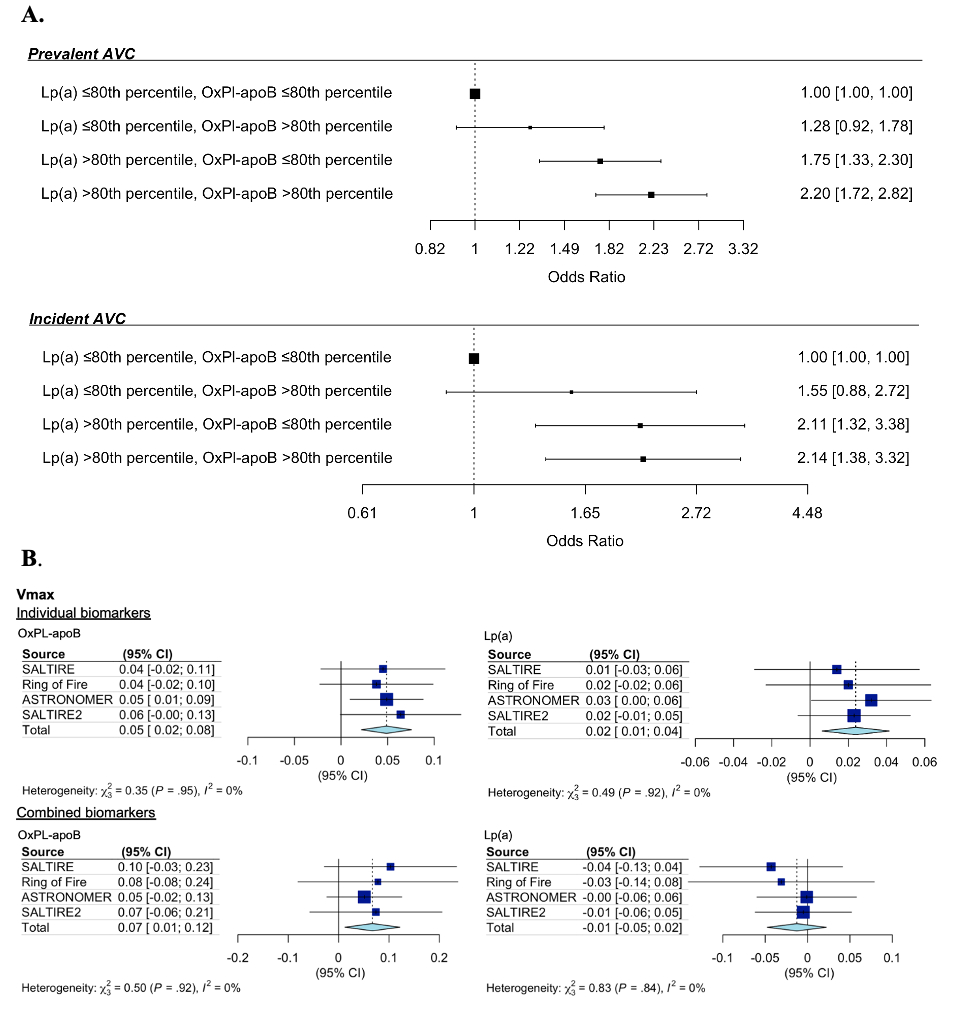Final ID: MDP1622
Oxidized Phospholipids and Calcific Aortic Valvular Disease
Oxidized phospholipids (OxPL) are carried by apolipoprotein B-100-containing lipoproteins (OxPL-apoB) including lipoprotein(a) [Lp(a)]. Both OxPL-apoB and Lp(a) have been associated with calcific aortic valve disease (CAVD).
Aims
We aimed to evaluate the independent associations between OxPL-apoB, Lp(a) and the prevalence, incidence, and progression of CAVD.
Methods
OxPL-apoB and Lp(a) were evaluated in the Multi-Ethnic Study of Atherosclerosis (MESA) and a participant-level meta-analysis of four randomized trials of participants with established aortic stenosis (AS). In MESA, the association of OxPL-apoB and Lp(a) with aortic valve calcium (AVC) at baseline and 9.5 years was evaluated using multivariable ordinal regression models. In the meta-analysis, the association between OxPL-apoB and Lp(a) with AS progression (annualized change in peak aortic valve jet velocity (Vmax)) was evaluated using multivariable linear regression models.
Results
In MESA, both OxPL-apoB and Lp(a) were independently associated with prevalent AVC (OR (95% CI) per SD: 1.19 (1.07-1.32) and 1.13 (1.01-1.27), respectively) with a significant interaction between the two (p<0.01). Both OxPL-apoB and Lp(a) were associated with incident AVC at 9.5 years when evaluated independently (interaction p<0.01). The OxPL-apoB*Lp(a) interaction demonstrated higher odds of prevalent and incident AVC for OxPL-apoB with increasing Lp(a) levels. Mediation analyses demonstrated that Lp(a) partially mediated the association between OxPL-apoB and AVC. In a 2x2 analysis, the greatest risk for both prevalent and incident AVC was observed when Lp(a) and OxPL-apoB were both above the 80th percentile (Figure). In the meta-analysis, when analyzed separately, both OxPL-apoB and Lp(a) were independently associated with faster increase in Vmax, but when evaluated together, only OxPL-apoB remained significant (ß 0.07, 95% CI 0.01-0.12, Figure).
Conclusions
OxPL-apoB is an independent predictor of the presence, incidence and progression of AVC and established AS, particularly in the setting of elevated Lp(a) levels and may represent a novel therapeutic target for CAVD.
- Bhatia, Harpreet ( University of California San Diego , San Diego , California , United States )
- Post, Wendy ( JOHNS HOPKINS UNIVERSITY , Baltimore , Maryland , United States )
- Tsai, Michael ( UNIVERSITY MINNESOTA , Minneapolis , Minnesota , United States )
- Criqui, Michael ( University of California San Diego , San Diego , California , United States )
- Shapiro, Michael ( Wake Forest Univ School of Medicine , Winston Salem , North Carolina , United States )
- Budoff, Matthew ( Lundquist Institute , Torrance , California , United States )
- Defilippis, Andrew ( Vanderbilt University Medical Cente , Nashville , Tennessee , United States )
- Thanassoulis, George ( MCGILL UNIVERSITY , Mont-royal , Quebec , Canada )
- Tsimikas, Sotirios ( UNIV CALIFORNIA SAN DIEGO , La Jolla , California , United States )
- Dweck, Marc ( University of Edinburgh , Edinburgh , United Kingdom )
- Craig, Neil ( University of Edinburgh , Edinburgh , United Kingdom )
- Capoulade, Romain ( DR Inserm Grand Ouest , Nantes , France )
- Pibarot, Philippe ( IUCPQ-UL , Quebec , Quebec , Canada )
- Trainor, Patrick ( Virginia Commonwealth University , Richmond , Virginia , United States )
- Whelton, Seamus ( JOHNS HOPKINS UNIVERSITY , Baltimore , Maryland , United States )
- Rikhi, Rishi ( Wake Forest Univ School of Medicine , Winston Salem , North Carolina , United States )
- Lidani, Karita ( Vanderbilt University Medical Center , Easton , Pennsylvania , United States )
Meeting Info:
Session Info:
Coronary Artery Calcium Score: A Critical Indicator of Cardiovascular Disease Risk
Monday, 11/18/2024 , 09:30AM - 10:55AM
Moderated Digital Poster Session
More abstracts on this topic:
Gaba Prakriti, Sabatine Marc, Bergmark Brian, O'donoghue Michelle, Giugliano Robert, Bellavia Andrea, Monsalvo Maria Laura, Flores-arredondo Jose, Kuder Julia, Atar Dan, Keech Anthony
12,13-diHOME Attenuates Pro-Arrhythmic Effect of High-Fat DietBuck Benjamin, Baer Lisa, Deschenes Isabelle, Chinthalapudi Krishna, Gallego-perez Daniel, Stanford Kristin, Hund Thomas, Areiza Natalia, Xu Xianyao, Elliott Austin, Wan Xiaoping, Nassal Drew, Lane Cemantha, Nirengi Shinsuke, James Natasha Maria
More abstracts from these authors:
Bhatia Harpreet, Mcparland James, Rikhi Rishi, Tsai Michael, Szklo Moyses, Tsimikas Sotirios, Yeang Calvin, Shapiro Michael
Characterization of plasma proteome perturbations to distinguish thrombotic myocardial infarction from non-thrombotic myocardial injury and chronic coronary artery disease.Tomar Shubham, Trainor Patrick, Lidani Karita, Mousavi Hossein, Defilippis Andrew

